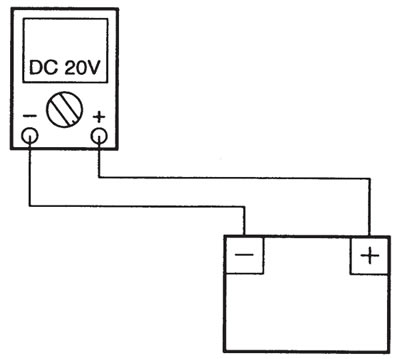Check:
- 1. main fuses
- 2. battery
- 3. charging voltage
- 4. startor coil assembly resistance
- 5. wiring (of the entire charging system)
Note: Before troubleshooting, remove the following part(-s):
- 1) battery cover
- 2) rider's seat
- 3) left side cover
- Troubleshoot with the following special tool(-s).
- Engine tachometer: 90890-03113
- Pocket tester: 90890-03112
1. Main fuse
Check the main fuse for continuity. Refer to "Checking the fuses".
Is the main fuse OK?
NO: Replace the fuse.
YES:
2. Battery
Check the condition of the battery. Refer to "Checking and charging the battery".
Open-circuit voltage: 12.8 V or more at 20°C
Is the battery OK?
NO: Clean the battery terminals.Recharge or replace the battery.
YES:
3. Charging voltage
Connect the engine tachometer to the spark plug lead of cylinder #1.
Connect the pocket tester (DC 20 V) to the battery as shown.
- Tester positive probe → battery positive terminal
- Tester negative probe → battery negative terminal

Start the engine and let it run at approximately 5000 r/min.
Measure the charging voltage.
- Charging voltage: 14 V at 5000 r/min
Note:
Make sure that the battery is fully charged.
Is the charging voltage within specification?
YES: The charging circuit is OK.
NO:
4. Stator coil assembly resistances
Remove the generator cover.
Connect the pocket tester (Ω x 1) to the stator coil assembly coupler as shown.
- Tester positive probe → white (1)
- Tester negative probe → white (2)
- Tester positive probe → white (1)
- Tester negative probe → white (3)

Measure the stator coil assembly resistances.
- Stator coil resistance: 0.36-0.44 Ω at 20°C
Is the stator coil assembly OK?
NO: Replace the stator coil assembly.
YES:
5. Wiring
Check the wiring connections of the entire charging system. Refer to "Circuit diagram".
Is the charging system's wiring properly connected and without defects?
NO: Properly connect or repair the charging system's wiring.
YES: Replace the rectifier/regulator.
